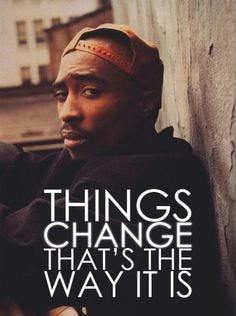As originally posted on Medium.com
This phrase is probably the bane of a few people’s existence.
I can’t continue.
I can’t figure it out.
I can’t go on.
I can’t. I can’t. I can’t.

To prevent this article from being very philosophical, I’ll relate it to a world that I’m very familiar with: fitness.
Now, let’s take a step back.
I’m in the business of changing people.
I change mindsets. I guide people through the avenue of exercise in order to achieve their desires of playing professional sports, fat loss, and improving their appearance.
When attempting to create a solution for change, one thought that has pervaded my mind the past few months is the thought of creating the correct solution for the issue at hand.
If you have the right solution at the wrong time it is still the wrong solution.
While no solution is 100% black or white in a given scenario, I think we can agree that for some solutions, some actions are just in plain hypocrisy of the desired outcomes.
If you want to lose weight, a midnight snack of a dozen mini-donuts every night, along with crushing half a gallon of milk every night after a lift (in addition to your every day meals) won’t necessarily be conducive to your goals.
On the same end, crushing Wheat Thins and only Wheat Thins after you do triceps and biceps at the local gym won’t get you to your immediate goal.

You not only need to decide on a set of actions, but you also need to surround yourself in the proper environment in order to change.
While I don’t fancy myself a wizard for creating change ala Tony Robbins, I do believe the following can create a better view on how your intangibles, such as your environment, can impact your goals.
A Non-Threatening and Encouraging Environment
For most goals, if you surround yourself in an environment that encourages your actions towards these goals, the more likely you will be able to model yourself and preen your actions towards a more streamlined thought process. This is fair enough and straight forward to understand.
A Low Stress, Anti-Change (Internal) Environment
If your environment stresses you out due to lack of change, you can either:
- Continue your path for internal change.
- Don’t do anything.
- Take a step back and follow what your environment is dictating, or allow the external world to decide your actions.
Anecdotally, about once every 2 or 3 weeks, I’ll get a message or email from someone online who is frustrated with their personal training job at their local commercial gym. Understandably so — there are often very little standards for what training looks like, and what management asks of you (often to sell sell sell).
At the same time, this person is yearning for change, yet has been working in the same gym for the past 3–10+ years. This person yearns for deeper knowledge, changes in environment, and improvement in work place.
Confusingly enough, this is the same person that does not know where to go when I ask them, “Have you thought about quitting? Moving?”
The world is bigger than your boutique commercial gym.
A High Stress, Anti-Change External Environment
At the same time, your environment also has the capacity to stress you by having too much pressure for improvement or change — a societal and environmental pressure entropy, if you will.

So if your environment stresses you out due to too much change occurring (that is, too much perceived by you) you can either:
- Allow your environment to swallow you up.
- Organize the disorder and maintain your integrity, staying on your path.
- Not do anything.
In the context of weight loss, many often mentally fight against many social pressures, whether it is from the context of after work drinks (and food), or family members’ resistance against eating salads for lunch.
There are correlations between societal and interpersonal pressures on body image and dietary influence, and to utilize the above study as a backside confirmation (that is, the study proves an understood thought process), it is a common thought process that if someone makes pressures you to think in a certain way to fit in, you often will.
I See No Changes…

So let’s put all of this together.
If someone repeatedly says “I can’t do this! (with the underlying tone being I am not physically or mentally prepared for this.)” then it can be assumed that they are:
- Not prepared for it physically.
- Not prepared for it mentally.
- Copping out.
- Intangibles (Do not have proper tools to accomplish the job, etc.)
There are both internal and external stressors at play here. On the one hand you have yourself and your belief system on whether or not you can accomplish said task. And on the other hand, you have your environmental “checkpoints” that discourage or encourage you from changing.
So what can you do? What is the correct play here?
Well, sometimes you need to understand that waiting out your environment is important for change.
And for other scenarios, you need to be the catalyst for change.
While this sounds like it is ending up to be another one of those articles that ends up being “It depends.” as the final answer, I’d like to offer another solution.
Decide on your goal, and pick your battles.
Know when to fold them, and know when to call people out on their bluff.
Whichever thought process you want to go with, understand that much like music, creating a solution is all about timing.
“How do you know when to do that?”
I’m glad you asked.
It comes down to experience. While some people may be geniuses and “have it all figured out”, more often then not those people are just rolling with the punches and going from one solution to the next until they do just that — until they figure it out through multiple and various experiences.
These individuals are literally rolling from one change to the next, just to make sure that they haven’t missed anything in the grand scheme of things. They still have a solid foundation, but they will try different things from time to time.
If something works, it will eventually find its way into the hands of someone who is in the habit of constant change. They make themselves open to the idea of change, and thus allow for their body to be a genesis of change. There is no stress involved with change, because it is inevitable for this person. Flexibility for perception will allow this person the ultimate capacity for understanding what type of solution to use at the correct time.
Solutions on Solutions on Solutions
So to end this on a relatively not-so-philosophical note, when it comes down to the phrase “I can’t do [xyz]”, I literally troubleshoot with them to find out about their mindset.
“Can you do this? How about this? If you do this before that, you can do this…”
I watch their body language. I watch their reactions to the various solutions that are possible. I dive deeper into some solutions, others I throw out the window. Sometimes people open up, others coil away due to the rapid fire of questions and solutions that have just occurred.
At the end, I often find out quickly enough if this person is ready for change.
It is unfortunate, but I can’t change you, or the people around you.
I can only guide you through a path, or down a path.
It’s ultimately up to you to find out what kinds of actions to take at what specific time.
You can’t change without that.
—
As always,
Keep it funky.

